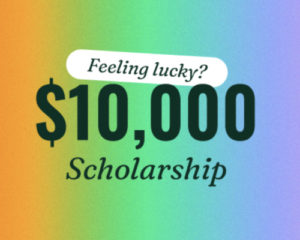Student-centric advice and objective recommendations
Higher education has never been more confusing or expensive. Our goal is to help you navigate the very big decisions related to higher ed with objective information and expert advice. Each piece of content on the site is original, based on extensive research, and reviewed by multiple editors, including a subject matter expert. This ensures that all of our content is up-to-date, useful, accurate, and thorough.
Our reviews and recommendations are based on extensive research, testing, and feedback. We may receive commission from links on our website, but that doesn’t affect our editors’ opinions. Our marketing partners don’t review, approve or endorse our editorial content. It’s accurate to the best of our knowledge when posted. You can find a complete list of our partners here.
What Is Tuition Reciprocity?

 By
Gabriel Jimenez-Ekman
By
Gabriel Jimenez-Ekman 
Gabriel Jimenez-Ekman is a content editor and writer at Scholarships360. He has managed communications and written content for a diverse array of organizations, including a farmer’s market, a concert venue, a student farm, an environmental NGO, and a PR agency. Gabriel graduated from Kenyon College with a degree in sociology.
Full BioLearn about our editorial policies

Cece Gilmore is a Content Writer at Scholarships360. Cece earned her undergraduate degree in Journalism and Mass Communications from Arizona State University. While at ASU, she was the education editor as well as a published staff reporter at Downtown Devil. Cece was also the co-host of her own radio show on Blaze Radio ASU.
Full BioLearn about our editorial policies

Bill Jack has over a decade of experience in college admissions and financial aid. Since 2008, he has worked at Colby College, Wesleyan University, University of Maine at Farmington, and Bates College.
Full BioLearn about our editorial policies

Maria Geiger is Director of Content at Scholarships360. She is a former online educational technology instructor and adjunct writing instructor. In addition to education reform, Maria’s interests include viewpoint diversity, blended/flipped learning, digital communication, and integrating media/web tools into the curriculum to better facilitate student engagement. Maria earned both a B.A. and an M.A. in English Literature from Monmouth University, an M. Ed. in Education from Monmouth University, and a Virtual Online Teaching Certificate (VOLT) from the University of Pennsylvania.
Full BioLearn about our editorial policies

In-state tuition offers a steep discount to any student interested in going to college. However, sometimes a student’s local state school isn’t the right fit. They might be interested in a program that the school doesn’t offer, or they may want to explore further from home. Luckily, tuition reciprocity agreements are here to help.
Tuition reciprocity allows students to get in-state tuition or other tuition discounts at state universities in other parts of the country. If your state has a tuition reciprocity agreement with another state, you should be sure to look into their schools. Let’s get into all you should know about tuition reciprocity!
Introduction to tuition reciprocity
Tuition reciprocity is an agreement between states that allows students from one state to attend institutions in the other state for in-state or reduced tuition. In-state tuition is usually significantly lower than out-of-state tuition at public schools, so this can be a game-changing factor in a student’s college choice.
Tuition reciprocity agreements are most common between neighboring states or states in the same region of the country, but this is not always the case. Some agreements exist between states that are across the country from one another.
Related: How to get in-state tuition as an out-of-state student
Apply to these scholarships due soon
Public vs. private
Most tuition reciprocity agreements only apply to public institutions, but some also apply to private schools. Keep in mind, though, that the discount is usually much less significant at private institutions. Whereas public institutions often cut their tuition in half for in-state students, private schools usually offer a much smaller discount.
Also see: What’s the difference between a public and private university?
Which states have these agreements?
The best way to figure out the answer to this question is to go through each tuition reciprocity agreement. Below we will list each agreement, what it covers, and which states are involved.
Southern Regional Education Board Academic Common Market
Covers: Public institutions in partner states when students enroll in an approved major not offered by the public schools in their home state
States included: Alabama, Arkansas, Delaware, Florida, Georgia, Kentucky, Louisiana, Maryland, Mississippi, Oklahoma, South Carolina, Tennessee, Texas, Virginia, and West Virginia
Southern Regional Education Board Regional Contract Program
Covers: Health degrees at public institutions in partner states
States included: Arkansas, Delaware, Georgia, Kentucky, Louisiana, Mississippi, and South Carolina
Western Undergraduate Exchange
Covers: Public undergraduate institutions in partner states
States included: Alaska, Arizona, California, Colorado, Hawaii, Idaho, Montana, Nevada, New Mexico, North Dakota, Oregon, South Dakota, Utah, Washington, Wyoming, and the Commonwealth of the Northern Mariana Islands
Western Graduate Exchange
Covers: Public graduate institutions in partner states
States included: Alaska, Arizona, California, Colorado, Hawaii, Idaho, Montana, Nevada, New Mexico, North Dakota, Oregon, South Dakota, Utah, Washington, Wyoming, and the Commonwealth of the Northern Mariana Islands
Professional Student Exchange Program
Covers: Public healthcare programs in partner states
States included: Alaska, Arizona, Colorado, Guam, Hawaii, Montana, Nevada, New Mexico, North Dakota, Utah, Wyoming, and the Commonwealth of the Northern Mariana Islands
New England Regional Student Program
Covers: Public institutions in partner states when students enroll in an approved major not offered by the public schools in their home state
States included: Connecticut, Maine, Massachusetts, New Hampshire, Rhode Island and Vermont
Midwest Student Exchange
Covers: Select public and private institutions in partner states
States included: Indiana, Kansas, Minnesota, Missouri, Nebraska, North Dakota, Ohio and Wisconsin
Also see: How to choose a college
What are the advantages of tuition reciprocity?
Tuition reciprocity offers a unique combination of advantages to its participants. Many students feel a desire to go to school in a place that’s new to them. They want to expand their horizons by experiencing a different part of the country. However, this can be an expensive decision given the steep out-of-state tuition rates compared to in-state tuition prices.
Tuition reciprocity is a way around that. It allows you to pay lower tuition at colleges that are farther from your home. It also means that if you don’t get into your state school, or you get in but don’t get generous aid, you have some other opportunities for schools that will offer you in-state discounts.
Aside from the geographical advantage, this wider selection can allow you to find a school with a strong program in your field of interest. For example, if you hope to enroll in a pre-med program and a neighboring state school has a renowned pre-med program, it offers a great opportunity so long as your states have tuition reciprocity agreements.
Related: In-state vs out-of-state tuition: everything you need to know
How do I apply for tuition reciprocity?
It’s important to note that schools do not automatically consider you for tuition reciprocity. You’ll have to apply directly through the reciprocity program. The process varies based on the program, but our list of programs above has links to each of their websites. Once you find the program for you, you can apply directly through their site.
Related: How to choose a college
How to find out if you qualify for tuition reciprocity at a school
The best way to find out whether you qualify for tuition reciprocity is to ask the admissions or financial aid office. The people working in these offices should have extensive knowledge of these programs, and will most likely be able to help you out. Their goal is to make the school as affordable as possible. So, programs such as tuition reciprocity are a huge asset for them and they will be quick to recommend it.
Also see: How to get in-state tuition as an out-of-state student
Frequently asked questions about tuition reciprocity
Does tuition reciprocity apply for private schools?
How long do I have to live in a state to get tuition reciprocity?
Can I lose my reciprocity benefits once they are granted?
Are graduate students eligible for tuition reciprocity?













 SAT" printed on his pencil">
SAT" printed on his pencil">
